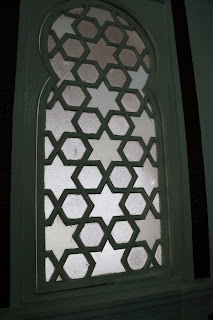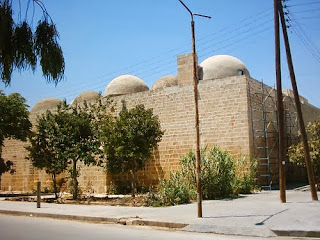https://www.dropbox.com/home/islamic%20arc.%20video
Base on the video, what the response given was more on how the occupant felt when being in the mosque, overall the nostalgic feeling and sense of welcoming is felt while walking or praying in the building compound. and the inscription and originality of the structure was part of most revealing on how the sense of space in Islamic architecture play its role. Welcoming, strong presence of religion essence, and comfort ability within an urban layout surround.
Wednesday, December 11, 2013
Saturday, November 30, 2013
Masjid Jamek
Masjid Jamek, is one of the oldest mosque in Malaysia which
retain its original identity .preserving the heritage and the utilization
factor. These mosque had a certain sense of space where it welcomes people with
a degree in such way when people came to the mosque they understands what is Islam its all about, the place is somehow had been expanded. The semi enclose
praying area even though new but with the column arrangement made it unity and
showing the path to the inner mosque all the way to the mihrab, another thing
is the material, though its red it gave some sense of nostalgic way back in the
beginning of its initial establishment, symbol of Islam were present just right
at the footsteps entrance to show that this is the way to the house of God.
Aside from that, an unexpected symbols appeared to there at the pivot window,
these star of David, are the symbols of the Hebrew but in Islamic tradition all
of the previous Abrahamic religion are our brothers, hence it gave the unity
and welcoming sense within the space among other. Some part were of the
building such like the marble for the tiling and Al-Qur'an inscription on the
columns were part of the old ones which serve as a reminder that old doesn’t
mean its old fashion but as a way to remembrance that gods path to righteousness,
is anyway anytime and everywhere possible.
Thursday, November 28, 2013
Ayyubid Dynasty Architecture
The Ayyubid
Founded by Salah' Ad Din in 11th century these dynasty when it comes to the architecture influence, they mainly adapt the predecessor style in the Fatimid Era, but with the idea and concept of understanding of barricading the compound due to the crusade war. These fortress kind of building built not only to be an iconic structure with just to be an area for safety but it was also for community of many religion and races to conduct their daily life. Base on the picture it show how the eventual structure we meant to be in the right angle in Islamic view, how a space were divided into a space of a certain purpose and islam as the guidance.
Egyptian Islamic Era
The Timeline of Egyptian Islamic Architecture.
It begins with the Fatimid Era, then begin the Ayyubid Era and ends with the Mamluk Era.
Thursday, September 26, 2013
Ayyubid Architecture
Ayyubid Architecture
Military architecture was the supreme expression of the
Ayyubid period, as well as an eagerness to fortify the restoration of Sunni
Islam, especially in a previously Shia-dominated Egypt by constructing Sunni
madrasas. The most radical change Saladin implemented in Egypt was the
enclosure of Cairo and al-Fustat within one city wall. Some of the techniques
of fortification were learned from the Crusaders, such as curtain walls
following the natural topography. Many were also inherited from the Fatimids
like machicolations and round towers, while other techniques were developed
simultaneously by the Ayyubids, particularly concentric planning.
Muslim women, particularly those from the Ayyubid family,
the families of local governors, and the families of the ulema ("religious
scholars") took an active role in Ayyubid architecture. Damascus witnessed
the most sustained patronage of religious architecture by women. They were
responsible for the construction of 15 madrasas, six Sufi hospices, and 26
religious and charitable institutions. In Aleppo, the Firdaws Madrasa, known as
the most impressive Ayyubid building in Syria, had regent queen Dayfa Khatun as
its patron.
In September 1183, construction of the Cairo Citadel began
under Saladin's orders. According to al-Maqrizi, Saladin chose the Muqattam
Hills to build the citadel because the air there was fresher than anywhere else
in the city, but its construction was not so much determined by the salubrious
atmosphere; rather it was out of defensive necessity and example of existing
fortresses and citadels in Syria. The walls and towers of the northern section
of the citadel are largely the works of Saladin and al-Kamil.[106] Two of
Saladin's towers were totally encased by semi-circular units. Al-Kamil
completed the citadel; he strengthened and enlarged some of the existing
towers, and also added a number of square towers which served as self-contained
keeps. According to Richard Yeomans, the most impressive of al-Kamil's
structures was the series of massive rectangular keeps which straddled the
walls of the northern enclosure. All of
al-Kamil's fortifications can be identified by their embossed, rusticated
masonry, whereas Saladin's towers have smooth dressed stones. This heavier rustic
style became a common feature in other Ayyubid fortifications, and can be seen
in the Citadel of Damascus and that of Bosra in Syria.
to Bab al-Nasr. He parceled out the building of the towers on this stretch of the wall to his princes and military officers; each tower was identified with a particular prince who inscribed his name into it. Later, az-Zahir Ghazi extended the eastern wall to the south and east, reflecting his desire to incorporate a dilapidated fortress, Qala'at al-Sharif, outside the city into Aleppo's enclosure. Bab Qinnasrin was completely rebuilt by an-Nasir Yusuf in 1256. This gate stands today as a masterpiece of medieval Syrian military architecture. Cumulatively, Ayyubid architecture left a lasting impression in Aleppo. The citadel was rebuilt, the water network was expanded, and streets and quarters were provided fountains and baths. In addition, dozens of shrines, mosques, madrasas, and mausoleums were built throughout the city.
The Ayyubid period in Jerusalem following its conquest by
Saladin was marked by a huge investment in the construction of houses, markets,
public bathes, and pilgrim hostels. Numerous works were undertaken at the Temple
Mount. Saladin ordered all the inner walls and pillars of the Dome of the Rock
to be covered in marble and he initiated the renovation of the mosaics on the
dome's drum. The mihrab of the al-Aqsa Mosque was repaired and in 1217,
al-Mu'azzam Isa built the northern porch of the mosque with three gates. The
Dome of the Ascension was also built and restoration work was done to the
existing free-standing domes of the Temple Mount.
The Map Of Cairo Citadel
 Cairo Citadel
Cairo CitadelThe Barrier of the Cairo Citadel, build by Ṣalāḥ ad-Dīn Yūsuf ibn Ayyūb King of Jerusalem and founder Ayyubid Dynasty.
Ṣalāḥ ad-Dīn Yūsuf ibn Ayyūb (Born September 19, 1173, Died March 4, 1193)
The machicolations and round towers were part of the adaptation by Ayyubid dynasty where it came from the Fatimid era. 3D laser scan data image of the Bab al-Barqiyya Gate in the 12th century Ayyubid Wall that borders Al-Azhar Park. This fortified gate was constructed with interlocking volumes that surrounded the entrant in such a way as to provide greater security and control than typical city wall gates; image from the Aga Khan Foundation/CyArk research partnership
The machicolations and round tower of the citadel
The iwan feature in the Cairo
Citadel quarters
Other
features were the ‘Iwan” where in Ayyubid era some of it was used as an opening
for war time where heavy object were thrown away through the ground upon the
enemy. Iwan is a rectangular hall or space, usually vaulted, walled on three
sides, with one end entirely open. The formal gateway to the iwan is called
pishtaq, a Persian term for a portal projecting from the facade of a building,
usually decorated with calligraphy bands, glazed tile work, and geometric
designs commonly associated with Islamic architecture.
With “Motifs” detail inside of
the Cairo Citadel made by marble and mosaic to show the wonder and beauty of
islam and the all mighty Allah. It shows the sincerity and honesty of the design and built with "Tawhid" understanding in mind just to glorify the almighty God.
Subscribe to:
Comments (Atom)


















































